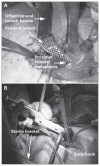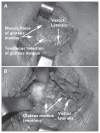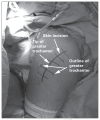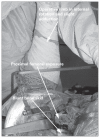Surgical approach in primary total hip arthroplasty: anatomy, technique and clinical outcomes
- PMID: 25799249
- PMCID: PMC4373995
- DOI: 10.1503/cjs.007214
Surgical approach in primary total hip arthroplasty: anatomy, technique and clinical outcomes
Abstract
Total hip arthroplasty (THA) has revolutionized the treatment of hip arthritis. A number of surgical approaches to the hip joint exist, each with unique advantages and disadvantages. The most commonly used approaches include the direct anterior, direct lateral and posterior approaches. A number of technical intricacies allow safe and efficient femoral and acetabular reconstruction when using each approach. Hip dislocation, abductor insufficiency, fracture and nerve injury are complications of THA, although their relative risk varies by approach. Numerous clinical trials have sought to elicit differences in patient-reported outcomes, complication rates and return to function among the surgical approaches. This review outlines some of the technical pearls of performing a THA through either a direct anterior, direct lateral or posterior approach. A literature review outlines the impact of surgical approach on clinical outcomes and clinically relevant complication rates.
L’arthroplastie pour prothèse totale de la hanche (PTH) a révolutionné le traitement de l’arthrite de la hanche. Il existe plusieurs approches chirurgicales pour l’articulation de la hanche, et chacune comporte ses avantages et inconvénients propres. Les approches les plus souvent utilisées sont l’approche antérieure directe, l’approche latérale directe et les approches postérieures. Plusieurs détails techniques contribuent à une reconstruction fémorale et acétabulaire sécuritaire et efficace avec chaque approche. La dislocation de la hanche, l’insuffisance des abducteurs, la fracture et les lésions nerveuses sont les complications de la PTH, quoique leur risque relatif varie d’une approche à l’autre. Plusieurs essais cliniques ont voulu mettre en lumière les différences quant aux résultats, aux taux de complications et au rétablissement fonctionnel déclarés par les patients selon les différentes approches chirurgicales utilisées. La présente synthèse résume quelques-unes des « perles techniques » pour l’exécution de la PTH soit par approche antérieure directe, latérale directe ou postérieure. Une revue de la littérature résume l’impact de l’approche chirurgicale sur les résultats cliniques et les taux de complications cliniquement importants.
Figures













References
-
- Charnley J. Arthroplasty of the hip. A new operation. Lancet. 1961;1:1129–32. - PubMed
-
- Information CIfH. Hip and knee replacements in Canada: 2012–2013 Quick Stats 2013. [accessed 2015 Feb. 12]. Available: www.cihi.ca/CIHI-ext-portal/xlsx/internet/STATS_CJRR2012-2013_EN.
-
- Light TR, Keggi K. Anterior approach to hip arthroplasty. Clin Orthop Relat Res. 1980;152:255–60. - PubMed
-
- Chechik O, Khashan M, Lador R, et al. Surgical approach and prosthesis fixation in hip arthroplasty worldwide. Arch Orthop Trauma Surg. 2013;133:1595–600. - PubMed
-
- Siguier T, Siguier M, Brumpt B. Mini-incision anterior approach does not increase dislocation rate: a study of 1037 total hip replacements. Clin Orthop Relat Res. 2004;426:164–73. - PubMed
Publication types
MeSH terms
LinkOut - more resources
Full Text Sources
Other Literature Sources
Medical
